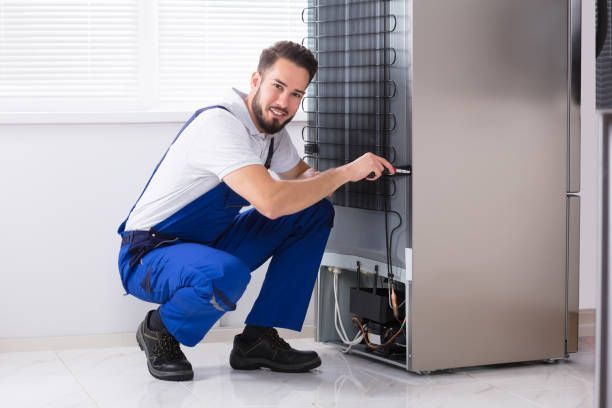How Efficient Appliances Help You Go Green with Repairs from Emergency Sub-Zero Repair Dependable Refrigeration & Appliance Repair Service
How Efficient Appliances Help You Go Green with Repairs from Emergency Sub-Zero Repair Dependable Refrigeration & Appliance Repair Service
Blog Article
The Ultimate Overview to DIY Device Repair Techniques
From refrigerators to dishwashing machines, understanding exactly how to troubleshoot and fix these devices can conserve you time and money. Are you ready to discover vital methods that will encourage you to manage repair services confidently?
Comprehending Common Appliance Troubles
When you rely upon your home appliances, it can be irritating when they instantly quit working or break down. Recognizing typical device issues can aid you fix problems successfully. If your fridge isn't cooling, inspect the temperature setups or evaluate the door seal for gaps. A malfunctioning washing maker may be due to a blocked drain filter or a damaged belt.
If your stove isn't heating, malfunctioning aspects or thermostat concerns might be to condemn,. Dishwashing machines often experience troubles with drainage, so make certain the filter is clean and the drainpipe hose pipe isn't kinked.
Additionally, listen for unusual audios; they usually show mechanical problems. By recognizing these indications, you can conserve time and potentially stay clear of expensive repair work. A little expertise goes a lengthy way in preserving your devices, so remain informed to maintain every little thing running smoothly.
Necessary Devices for DIY Repairs
Prior to diving right into DIY device repairs, it is essential to gather the right devices to assure the procedure goes smoothly. Begin with a great collection of screwdrivers, consisting of both flathead and Phillips, as they're essential for opening most appliances. You'll also want a pair of pliers for grasping and turning cables or tiny elements.
Don't neglect a multimeter; it assists you examination electrical parts and detect concerns efficiently. A socket set is convenient for loosening up or tightening up screws, while an energy blade can be valuable for opening or cutting wires packaging.
Finally, consider having a flashlight handy to light up dark areas inside your devices. With these essential tools, you'll be fully equipped to tackle numerous fixings, conserving both money and time. Gather your gear and obtain all set to roll up your sleeves!
Security First: Safety Measures to Take
Before you start any appliance repair work, it's vital to prioritize safety. Make particular you put on individual safety equipment, disconnect the power source, and maintain your workspace arranged. These basic safety measures can help protect against mishaps and guarantee a smoother fixing procedure.

Personal Protective Equipment
Safety equipment is a vital part of any kind of DIY appliance repair service task. Steel-toed boots are likewise a clever option, specifically when raising heavy appliances. Keep in mind, being prepared with the right equipment maintains you risk-free and concentrated on finishing your repair work efficiently.
Source Of Power Interference
To guarantee a safe DIY appliance repair work, detaching the power source is essential. This easy step avoids electric shocks and guarantees that you can focus on the repair without stressing about unintended activation. As soon as you're certain that the power is separated, you can with confidence continue with your repair work, knowing you have actually taken the required preventative measures to secure on your own.
Work Area Organization
An efficient job area can make all the difference in your Do it yourself device repair service project. Beginning by removing your work area of clutter to avoid distractions and mishaps. A neat room not only improves effectiveness but also keeps you risk-free while you work on your device repair.
Step-by-Step Guide for Refrigerator Repair Works
When your refrigerator begins acting up, it can be frustrating, yet tackling the problem on your own can conserve you time and cash. Check for typical problems like temperature variations or uncommon sounds. For a loud refrigerator, inspect the follower and validate it's not obstructed.
If there's water merging within, examine the door seals for damages or dirt, and clean them if necessary. For ice build-up, clear the defrost drainpipe. Plug the fridge back in and monitor it for a couple of hours once you've attended to the problem. If the trouble persists, you may need to change a damaged part, like the compressor or fan electric motor. Keep in mind, don't think twice to seek advice from the guidebook or seek professional help if required.
Taking Care Of Washing Equipment Problems
Just like fridges, washing makers can provide their very own set of challenges, but many issues can be fixed with a bit of troubleshooting. If your equipment will not start, examine the power cord and confirm it's plugged in.
Tightening these can often address the trouble. Normal maintenance, like cleaning the filter, can prevent lots of problems from occurring.
Troubleshooting Stoves and Cooktops
Just how can you troubleshoot typical problems with your oven or cooktop? Beginning by inspecting the power supply. Ensure it's connected in and the circuit breaker is not stumbled. If it's a gas stove, verify the gas valve is open. Next, examination the heaters: if they don't fire up, clean the igniter and look for blockages in the heater ports.
If your stove isn't heating, evaluate the temperature level settings and confirm the door seals snugly. A defective home heating component could likewise be the perpetrator; you might require to change it if it's damaged.
For uneven food preparation, rotate your frying pans and consider making use of an oven thermometer to validate precise temperature levels. If you listen to uncommon noises or scent gas, turn off the appliance promptly and seek advice from a professional. By following these actions, you can determine and settle several usual stove and cooktop concerns efficiently.
Repairing Dishwashing Machines Facilitated
When your dish washer starts breaking down, it can be aggravating, however attending to usual issues isn't as hard as it seems. You'll find out step-by-step troubleshooting approaches that will certainly aid you determine the trouble, along with the vital devices you'll need to tackle repair services yourself. Allow's make repairing your dishwasher a breeze!
Common Dish Washer Concerns
While dishwashing machines are made to make your life easier, they can occasionally run into typical problems that leave you really feeling discouraged. If your dishwasher's door won't latch, it could be an easy issue with the latch system or door seal. Attending to these concerns early can conserve you time and hassle down the road.

Step-by-Step Troubleshooting
Prior to diving right into repair work, it's essential to recognize the particular problem your dishwashing machine is dealing link with. If your dishwashing machine won't start, these details examine the power supply and door latch. By methodically dealing with each possible problem, you can identify the trouble and take the required actions to repair it, making your dishwasher function like new once more.
Vital Repair Work Devices
Having the right tools at your disposal can make all the distinction when fixing your dishwashing machine. Start with a screwdriver collection, as you'll commonly need both Phillips and flathead options. A multimeter's crucial for identifying electrical concerns, while pliers can assist you grip and adjust numerous elements. Don't neglect a bucket or towels for any kind of water spills throughout repair services.
You may likewise desire a degree to guarantee your dishwashing machine's effectively aligned. With these essential tools, you'll be well-appointed to tackle any type of dishwashing machine fixing challenge that comes your way.
Often Asked Questions
If an Appliance Is Worth Repairing?, how Do I Identify.
To figure out if a device's worth repairing, consider its age, repair costs, and current value. If repair work surpass half the replacement expense, you may want to buy a new design instead.
Can I Find Substitute Components Locally for My Appliance?
Yes, you can usually locate replacement components in your area for your home appliance. Check equipment shops, appliance service center, or regional classifieds. Do not fail to remember to bring the model number to guarantee you obtain the right part!
What Usual Mistakes Should I Prevent When Repairing Home Appliances?
When fixing home appliances, stay clear of rushing through diagnostics, neglecting safety preventative measures, or utilizing wrong tools. Do not skip reviewing manuals or enjoying tutorials; they provide necessary assistance. Hold linked here your horses and detailed to ensure effective fixings and prevent further damage.
The length of time Does a Typical DIY Appliance Fixing Take?
A common do it yourself appliance repair work generally takes one to three hours, depending upon the intricacy. You'll wish to gather your devices and materials first, and comply with guidelines thoroughly to prevent unneeded hold-ups.
Are There Any Type Of Warranties for DIY Device Services?
When you tackle DIY home appliance fixings, warranties usually do not cover your job. Nonetheless, some manufacturers could honor guarantees for parts you replace. Always check your appliance's guarantee terms before starting any type of repair services to prevent concerns.
Prior to diving right into Do it yourself device fixings, it's important to gather the right devices to assure the procedure goes efficiently.Prior to you begin any device fixing, it's essential to focus on safety and security.To assure a secure Do it yourself home appliance repair service, detaching the power resource is crucial.An efficient job area can make all the difference in your DIY device fixing job. Always check your home appliance's service warranty terms prior to starting any fixings to stay clear of problems.
Report this page